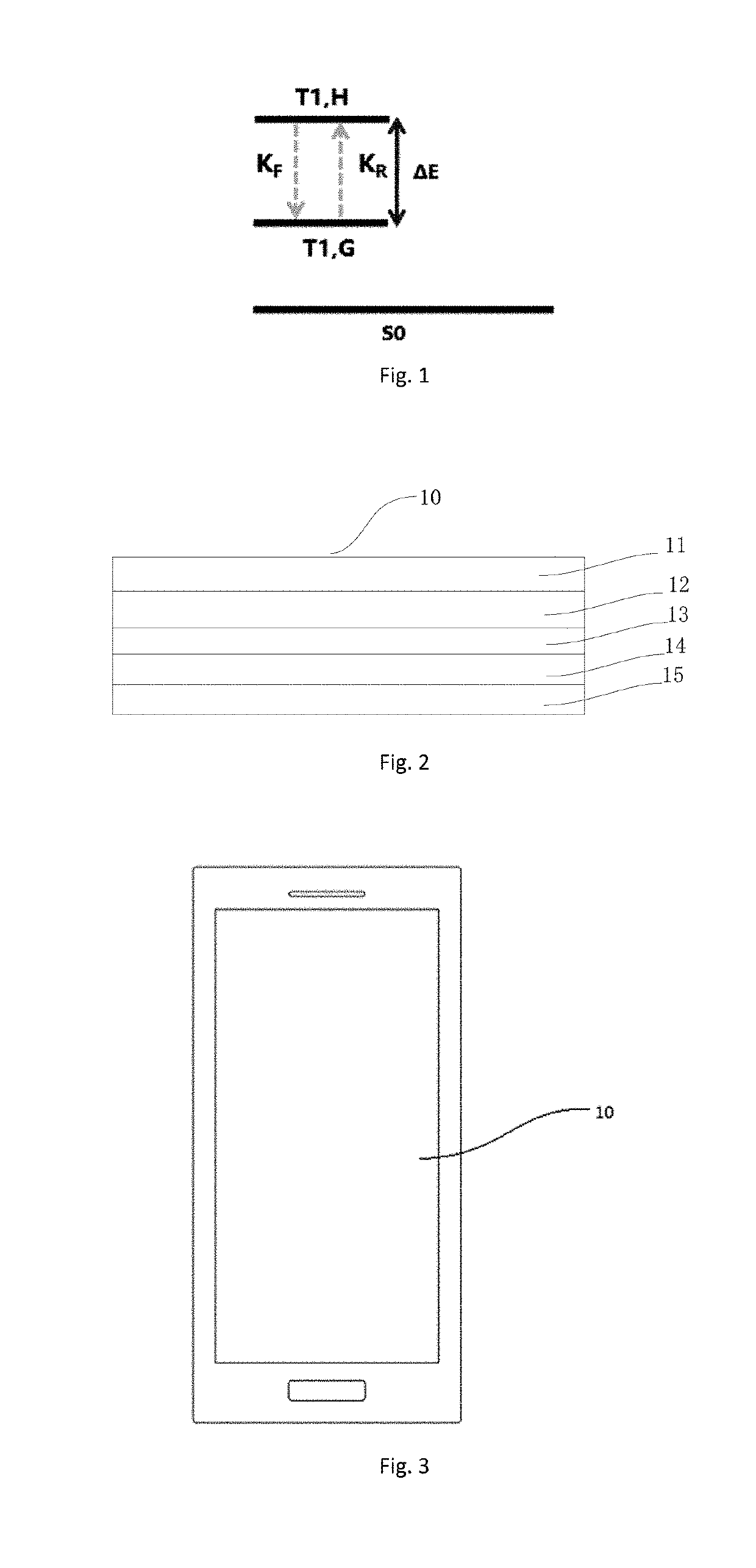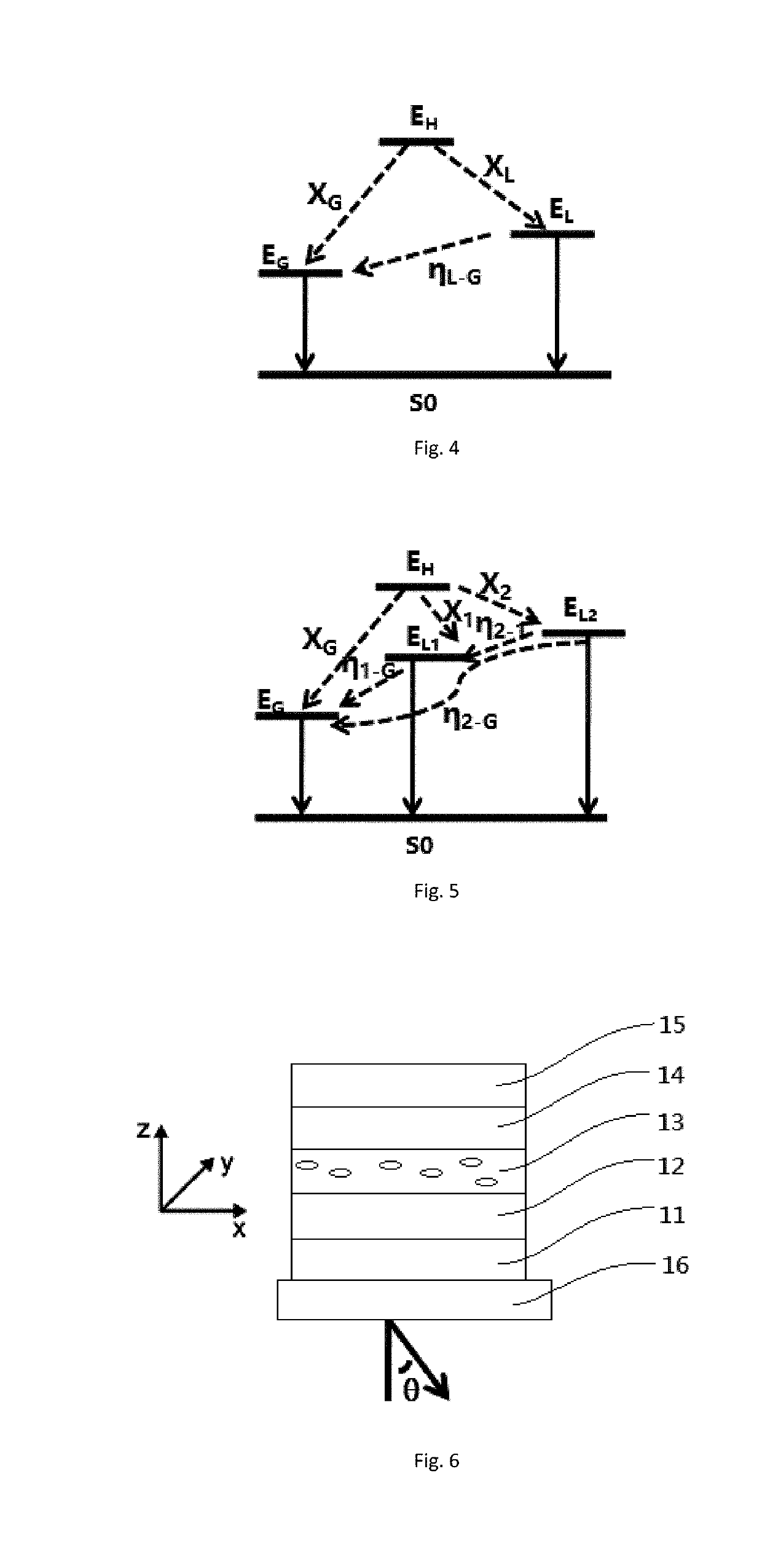Luminescent Device and Display Device Using Same
a technology of luminescent devices and display devices, which is applied in the direction of luminescent compositions, organic semiconductor devices, luminescent compositions, etc., can solve the problems of low luminescence efficiency, high turn on voltage, and poor device performance of such devices
- Summary
- Abstract
- Description
- Claims
- Application Information
AI Technical Summary
Benefits of technology
Problems solved by technology
Method used
Image
Examples
embodiment 1
[0093]To construct the multilayer device structure of ITO / HIL / HTL / step photoluminescence layer / ETL / EIL / cathode, the chemical structure of some organic materials is as follows:
[0094]Among them, MoO3 is used as a hole injection layer material, TAPC is used as a hole transport layer material, and mCP is used as a host material. Ir(dfppy)2 / (tpip) is used as an energy level transition layer material, and a doping amount is 15 wt. %, Ir(tfmppy)2 / (tpip) is used as a green light oriented guest material, and a doping amount is 5 wt. %. TPBI is used as an electron transport layer and a hole barrier material, and LiF is as an electron injection layer material and Al is used as a cathode. Ir(tfmppy)2(tpip) is a heterocyclic ligand metal chelate with large vertical transition dipole moment DVT that can be used as a light-oriented guest material.
[0095]Analysis of energy level and spectral characteristics:
[0096]The triplet energy level of TAPC T=2.87 eV, and the triplet energy level of TPBi T1=2.7...
embodiment 2
[0119]The multilayer device structure of ITO / HIL / HTL / step light-oriented photoluminescence layer and ETL / EIL / cathode is constructed. The chemical structure of some of the organic materials used is as follows:
[0120]In green or yellowish-green devices, mCP is used as the host material, FIrpic is used as the transition layer material, and the green or yellow light light-oriented guest materials are taken from Ir(ppy)3, Ir(ppy)2(acac), Ir(bppo)2(acac), Ir(chpy)3, Ir(bppo)2(ppy). The properties of the light-oriented guest materials are shown in Table 1.
[0121]Analysis of energy level and spectral characteristics:
[0122]The triplet energy level of the host material mCP T1=2.9 eV;
[0123]The triplet energy levels of the energy level transition layer FIrpic are higher than T1 energy level of green or yellowish-green light oriented guest materials (as shown in Table 1).
[0124]According to the spectral data of the above host material, the energy level transition layer material and the light-orient...
embodiment 3
[0137]The multilayer device structure of ITO / HIl / HTL / step photoluminescence layer and ETL / EIL / cathode is constructed. The chemical structure of some organic materials used is as follows:
[0138]The red light device uses CBP as the host material, and Ir(ppy)3 as the energy level transition layer. The red light-oriented guest material is obtained from Ir(MDQ)2(acac), Ir(ppy)2(bppo), Ir(piq)3. The properties of the light-oriented guest materials are shown in Table 1.
[0139]Analysis of energy level and spectral characteristics:
[0140]The triplet energy levels of the host material CBP and the transition layer Ir(ppy)3 are higher than the T1 energy level of the red light-oriented guest material.
[0141]In order to further investigate the energy transfer efficiency of the host material, the energy level transition layer material and the light-oriented guest material in the luminescent layer, the spectral information of the three materials is as follows:
[0142](1) The photoluminescence spectra of ...
PUM
| Property | Measurement | Unit |
|---|---|---|
| luminescent | aaaaa | aaaaa |
| energy level | aaaaa | aaaaa |
| energy | aaaaa | aaaaa |
Abstract
Description
Claims
Application Information
 Login to View More
Login to View More - R&D
- Intellectual Property
- Life Sciences
- Materials
- Tech Scout
- Unparalleled Data Quality
- Higher Quality Content
- 60% Fewer Hallucinations
Browse by: Latest US Patents, China's latest patents, Technical Efficacy Thesaurus, Application Domain, Technology Topic, Popular Technical Reports.
© 2025 PatSnap. All rights reserved.Legal|Privacy policy|Modern Slavery Act Transparency Statement|Sitemap|About US| Contact US: help@patsnap.com



